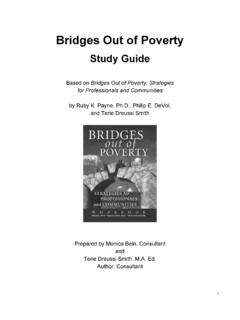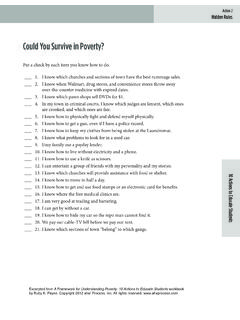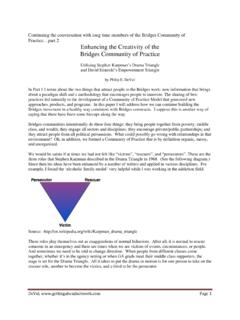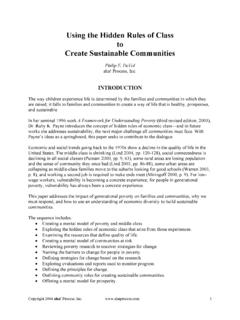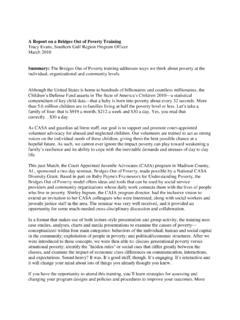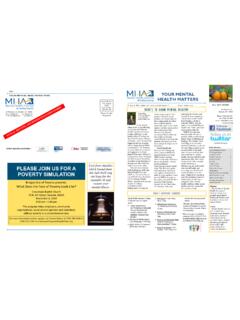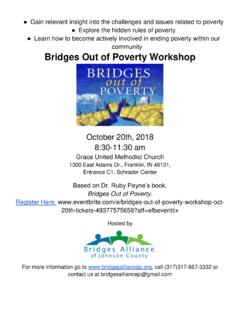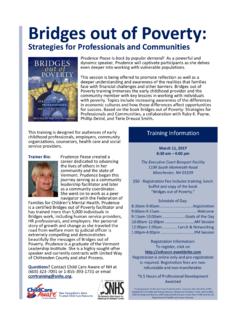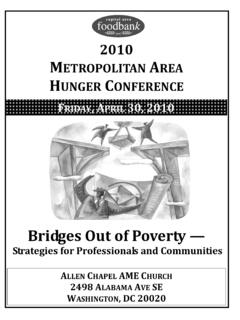Transcription of 12 Thinking Tools for Bridges Out of Poverty Initiatives
1 2014 by DeVol & Associates, LLC. All rights reserved. and Practice in a Bridges InitiativeBridges Out of Poverty workshops are known for changing the way people think about Poverty and economic class. People have aha moments that deepen into insights that are so powerful that there is no going back to their old way of Thinking . These in turn deepen into paradigm shifts that al-ter every aspect of their work on Poverty . It is not the purpose of this paper to reiterate the basic con-tent of Bridges but to distinguish between theory and practice in Bridges work. The practices may be varied and complex but the theory must bring clarity to our work. The theory: When individuals are under-re-sourced to the extent that they spend most of their time and energy trying to keep their heads above water, their daily living experience becomes dom-inated by the tyranny of the moment.
2 Rather than spending time and energy building resources for a better future, their time and energy go toward try-ing to stabilize their unstable world, and they end up staying stuck in a life of institutions and communities are under-resourced to the extent that they spend too much time and energy trying to keep their heads above water, they behave in very similar ways to un-der-resourced individuals: They spend their time solving concrete problems using strategies that originate from the same mindset that created the Thinking Tools forBridges Out of Poverty Initiativesby Philip E. DeVolThe solution for individuals, institutions, and communities is to build stability and practice: Bridges Initiatives have a common language about Poverty and matters of econom-ic class.
3 Bridges Initiatives use the following 12 Thinking Tools to build stability and resources at four levels: individual, institutional, community, and policy. The goal of Bridges Initiatives is to prevent Poverty , alleviate suffering, aid those who are making the transition out of Poverty , and cre-ate communities where everyone can live familiar with Bridges will be aware of most of the following mental models. Mental models are used to help make abstract ideas more concrete and to help us remember ideas by repre-senting them with visual images. Mental models help us learn quickly, remember longer, and apply the concepts in deeper ways. Thus the term think-ing Tools .
4 Mental models tend to provide our fi rst aha mo-ment and new insights that attract us to Bridges . For some people, attraction moves quickly to ac-tion. Early adapters have generated a number of programs and approaches that have become foun-dational to the Bridges movement. But Poverty is a complex problem that demands a comprehensive approach. And therein lies the challenge. Poverty is not resolved with a single program or even set 2014 by DeVol & Associates, LLC. All rights reserved. programs, because there so many variables. Bridges is not a program. It is a set of constructs that can be applied in many settings and in many ways. The ensuing Thinking Tools can help individuals, organizations, and communities create, embed, and expand solutions.
5 The pattern for explaining these 12 Thinking Tools has these six elements:a. A problem statement describing how things are nowb. A mental model representing the Thinking toolc. The context in which the tool is applied a description of how it fi ts into Bridges workd. Core ideas of the Thinking tool e. Ways to use the toolf. Information on where to learn moreTable of Contents: 12 Thinking Tools1. Triple Lens2. Mental Models of Economic Class3. Theory of Change4. Three Classes at the Table5. Community at Risk6. Bridges Steering Committees7. Community Sustainability Grid8. Bridges Continuum9. Getting By Resources vs. Getting Ahead Resources10. Methodology: Innovation11. Cycle of Innovation: Knowledge and Technology12.
6 Bridges Communities of Practice Model 2014 by DeVol & Associates, LLC. All rights reserved. Triple LensHow things are now: Individuals learn about Poverty through personal experience, stories in the news, reading, and general debate but rarely through an intention to fully understand this com-plex problem. Without a structure for processing the complexities of Poverty , without a way to or-ganize our Thinking , our responses to Poverty will continue to be woman in Poverty saw a sign on a caseworker s door that read, Your failure to plan does not con-stitute an emergency for me. The triple lens has us fi rst analyze the dynamics between the client and caseworker, helping to explore and decode class interactions from both sides of the desk.
7 It would deepen the understanding by analyzing the driving forces of the institution and the role of the institution in the using the triple lens, we develop new ideas, discover how to apply new concepts, and make necessary changes. This tool helps us do thor-ough work. As for clients who are late, it s pos-sible that they might need to make some changes, but this tool reminds us that they don t need to change any more than those who are in the institutions and community. Context: The triple lens is a structure by which Poverty can be assessed and processed thoroughly. Looking at Poverty through a single lens be it individual, organizational, or community will not provide the depth of understanding that comes from viewing Poverty through all three lenses.
8 Core ideas: Poverty elicits strong opinions; it s easy to take sides or to blame the other person or institution. This Thinking tool helps replace judg-ments with understanding. The fi rst place that confl icts usually occur is the interaction between people in Poverty and people in institutions, such as caseworkers, supervisors, and healthcare work-ers. Learn more: Read Tactical Communication: Mastering effective interactions with citizens from diverse economic backgrounds, Jodi R. Pfarr, to use the tool Use the triple lens to deepen understanding of the core elements of a Bridges workshop: the mental models of class, the causes of Poverty , hidden rules, resources, and language.
9 When embedding the concepts in our organization or designing a new community program, the question becomes: What would we learn by applying the triple lens? Adapted from J. Pfarr Consulting 2014 by DeVol & Associates, LLC. All rights reserved. Mental Model for Poverty Mental Model for Middle Class Mental Model for WealthAnalytical TermsMental bandwidthConcrete/abstractPowerInvisible , little infl uence/powerfulStabilityDaily instability/long-term stabilityTime horizonTyranny of the moment/long viewProblem-solving approachReactive problem solving with relationships/proactive problem solvingFinancial securityDaily insecurity/long-term securitySource: Philip E. DeVol, adapted from Facilitator Notes for Getting Ahead in a Just-Gettin -By World, Mental Models of Economic ClassHow things are now: In the United States few of us know how people in other classes live.
10 So-cial connectedness has been decreasing since the 1970s as income segregation in housing has sepa-rated us into economic enclaves. This has led to a lack of knowledge and understanding between/among the classes. Programs in education, health, and workforce development that are for people in Poverty are more often than not designed without their input. Thus the phrase, If it s about us, with-out us, it s not for us. CONNECTIONSVACATIONTRAVELPRIVATE CLUBS &DIRECTORSBOARD OFNATIONAL &ASSOCIATIONSINTERNATIONALADVISORSSPONSO RSHIP,ATTENDANCEMEDIA &POLITICALOVERSIGHT OFCORPORATE PROPERTY,PERSONNEL CONCERNSLAWYERS &ACCOUNTANTSEVENT LINKAGESRELATIONSHIPSTRANSPORTATIONFOODC HILDRENCLOTHINGFAMILY & HEALTHMENTALHEALTHENTERTAINMENTJOBSSAFET YCRIMINALJUSTICECHILDCAREHOUSING FRIENDSDEPENDENCYCHEMICALDEBTSYSTEMAGENC Y TIMEACHIEVEMENTEDUCATIONPREVENTIONRETIRE MENTCHILDRENINTERESTSHOBBIES &FA M I LY & ASSETSHOUSING &CAREERSVACATIONSCIVIC GROUPSCLUBS &CREDIT CARDDEBTCHILDCARECOST OFPAYMENTSMORTGAGELONGER HOURSWORKING FRIENDSEDUCATIONCOST OFContext.
